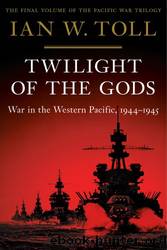Twilight of the Gods by Ian W. Toll

Author:Ian W. Toll
Language: eng
Format: epub
Tags: Epub3
ISBN: 9780393651812
Publisher: W. W. Norton & Company
Published: 0101-01-01T00:00:00+00:00
Nearing the beach, the coxswains struggled to keep the little flat-bottomed craft from broaching. Six-foot waves lifted the boats and set them down hard, with a crunch of coarse sand under the hull. The ramps dropped with a bang and the marines trudged up the steep-sided beach. It was a hard climb. The “sand” under their boots was soft volcanic cinder, and their boots sunk to the laces. On the steeper sections, they found themselves slipping and sliding backward. A rifleman with the 4th Marine Division said it was like “trying to run in loose coffee grounds.”38
At first, the situation on the landing beaches seemed manageable. Unit commanders ashore radioed encouraging reports: “Light machine gun and mortar fire. . . . Light opposition on the beach. . . . Only sporadic bursts of mortar fire.”39 Colored flares went up, signaling a successful landing, and the second and third waves of boats followed quickly behind the first. On the Green and Red Beaches, at the southern end of the beachhead, the assault troops overran enemy blockhouses and pillboxes and advanced inland to a distance of 300 yards, taking only minimal losses. Some speculated that the naval barrage and air support had done the trick; Holland Smith guessed that the Japanese “lay stunned under the terrific explosive shock of our naval gunfire.”40 In the first ninety minutes of the battle for Iwo Jima, the marines put eight battalions ashore, including two tank battalions and elements of two artillery battalions.
The hardest fighting that morning was in the craggy terrain at the far northern flank, above Blue Beach 2, in an area the marines called the “Rock Quarry.” Here the gorges and rock faces were seemingly impervious even to direct hits by 1,000-pound bombs and large-caliber naval weapons. The terrain had been improved with prolific use of concrete and rebar, and all possible approach lanes were swept by machine guns. From the moment they landed, the 3rd Battalion, 25th Marines were under punishing machine gun and mortar fire. As they advanced over the first terrace, they drew a crossfire from pillboxes inland and to the south. To Lieutenant Colonel Justice M. Chambers, the battalion commander, the Japanese seemed to be targeting them from every direction: “You could have held a cigarette and lit it on the stuff going by. I knew immediately we were in for one hell of a time.”41 The Rock Quarry was the hinge upon which the entire U.S. line would turn. The 25th Marines had a critical job to do, and they knew it. They could do nothing but take the casualties and keep fighting, so they did.
At 11:00 a.m., the Japanese mortar and artillery barrage suddenly intensified. The weapons had been preregistered to hit the invasion beaches, between the surf line and the top terraces, where the American troops were densely concentrated in exposed positions. The naval task forces and support planes did their best to silence this fire, but the Japanese gun emplacements on Suribachi and the Motoyama Plateau were well camouflaged, and many could not be seen even from overhead.
Download
This site does not store any files on its server. We only index and link to content provided by other sites. Please contact the content providers to delete copyright contents if any and email us, we'll remove relevant links or contents immediately.
Blood and Oil by Bradley Hope(1250)
Daniel Holmes: A Memoir From Malta's Prison: From a cage, on a rock, in a puddle... by Daniel Holmes(1118)
Ambition and Desire: The Dangerous Life of Josephine Bonaparte by Kate Williams(1088)
Wandering in Strange Lands by Morgan Jerkins(1019)
It Was All a Lie by Stuart Stevens;(942)
What Really Happened: The Death of Hitler by Robert J. Hutchinson(872)
London in the Twentieth Century by Jerry White(848)
Time of the Magicians by Wolfram Eilenberger(844)
The First Conspiracy by Brad Meltzer & Josh Mensch(813)
Twilight of the Gods by Ian W. Toll(813)
The Japanese by Christopher Harding(803)
A Woman by Sibilla Aleramo(797)
Lenin: A Biography by Robert Service(780)
The Devil You Know by Charles M. Blow(779)
Reading for Life by Philip Davis(775)
Cleopatra by Alberto Angela(769)
Twelve Caesars by Mary Beard(769)
1965--The Most Revolutionary Year in Music by Andrew Grant Jackson(715)
The Life of William Faulkner by Carl Rollyson(714)
